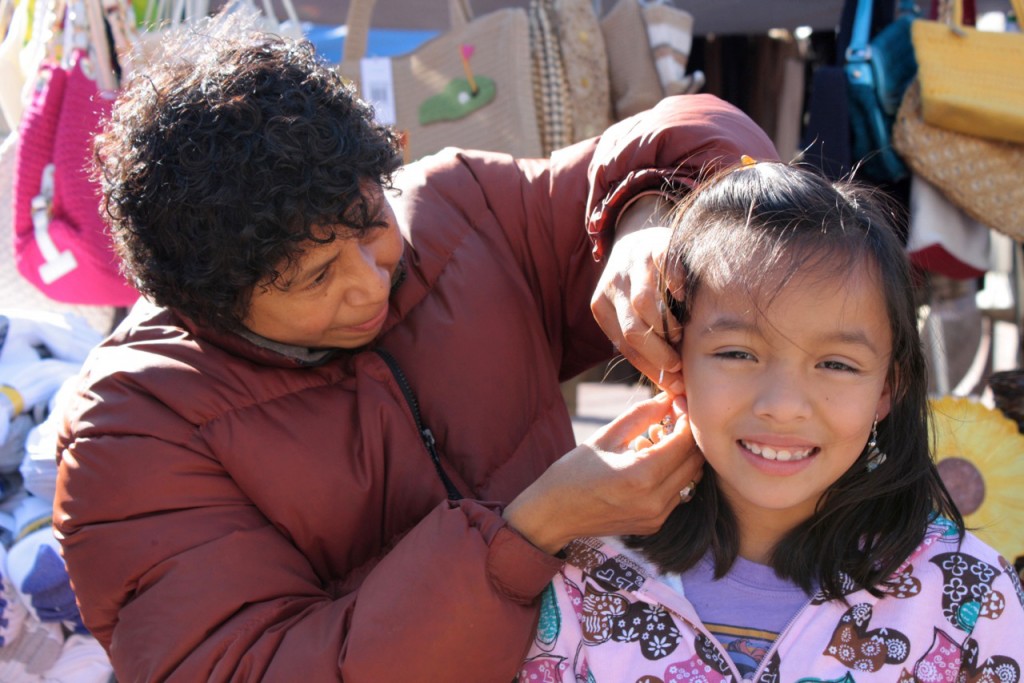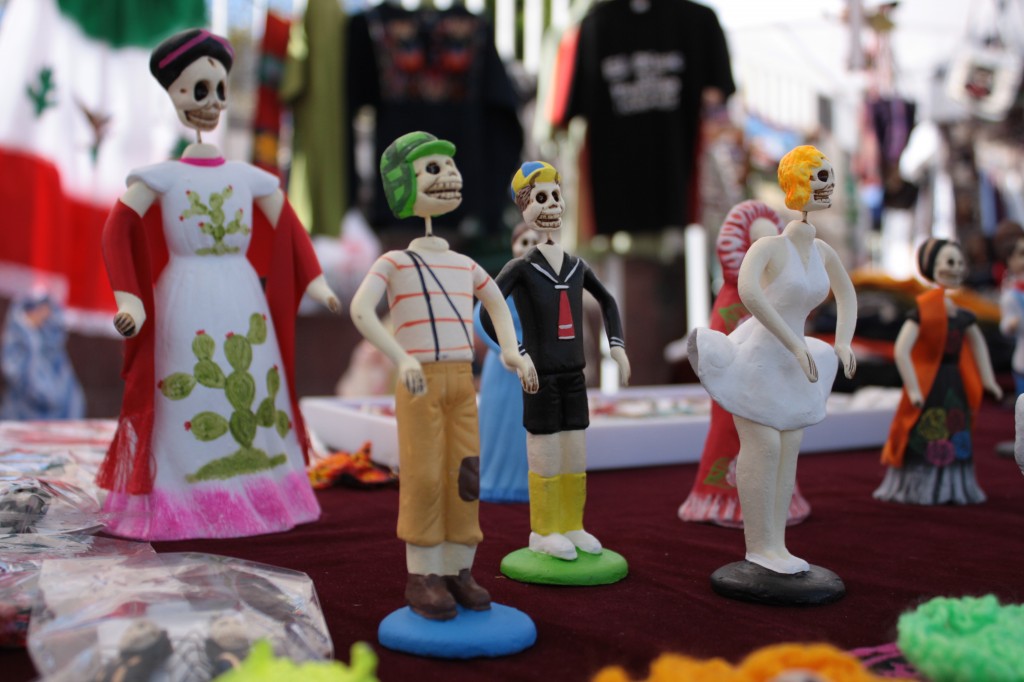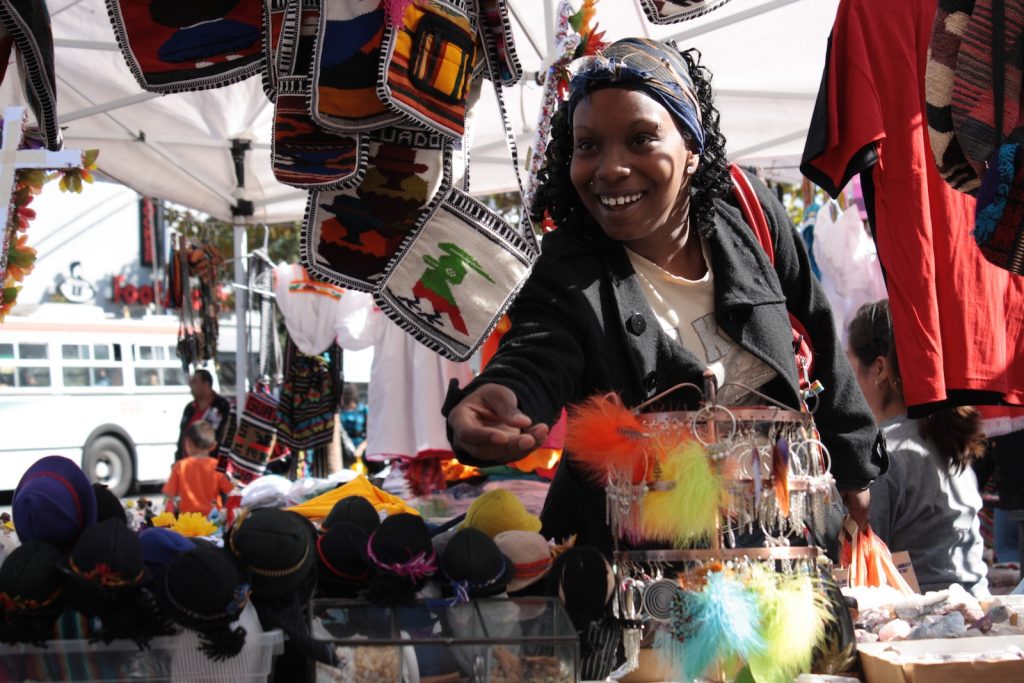Diana Medina puts her dog Pacha in a backpack and jumps on her motorcycle. It’s Saturday and time for the Mission Artisan Market, where Medina has a silver-jewelry booth.
“Before I owned a store, it was the artisans market that gave me the opportunity to sell my merchandise,” said Medina, recalling what life was like only a year and a half ago. Nowadays, the market’s only an extension of her Diju Jewelry store on 26th Street.
The artisans market is where street vendors, artists and store owners like Medina sell their merchandise. They can come from as far as Peru and as near as Mexico. Every Saturday, they set up on the southwest corner of the 24th Street BART station, turning that corner into a space that, for many, offers memories of home.
Vicky Valdez sells flowers at the market. From her spot, she hears the music and watches regular people break into spontaneous dance. “The sales aren’t always good but I like to come here because I feel happy,” she said.
Merchants and customers were startled when, a few weeks ago, police officers visited and asked to see permits and identifications. “We were intimidated,” said Medina, who tried to answer an officer’s questions but wasn’t able to fully express herself in English.
Vendors visited the Mission District police to explain who they are to Captain Steve Tacchini and clear up any misunderstanding. The officer who interrogated Medina didn’t know the market has been operating officially for almost two years.
The idea of an arts and crafts market started with three Latino business owners and the help of the Mission Economic Development Agency, a nonprofit that promotes community economic development.
“We wanted to create an organization for artisans and small businesses,” said Cesar Oyagata, an indigenous Ecuadorian artisan, and owner of G.G Tukuy on 24th Street, who has been involved with the market from the beginning. Along with other merchants the Mission Small Business Association was formed.
In 2007, BART gave the association a permit to rent and operate as a market in their space. “Only after it happened we realized that we could do it,” said Sonia Ttito, from Qusqo Maky, a family-owned store on 22ndStreet.
The association has only 16 members but has become well organized over time. It has a democratically elected board that rotates every year. This year Medina was voted treasurer and administrator. “We noticed that she was reliable,” said Oyagata, who was president during the previous year.
Now a reality, the Mission Artisans Market attracts a good Saturday crowd. “It feels very cultural,” said Mano Castillo, a Nicaragu native who, like many others, stood mesmerized in front of a live salsa band in the market.
“It is perfect,” said Lubia Ruiz, a passerby lured to the market by the music. She liked the Guatemalan handmade blouses, because she too was made in Guatemala.

Latinos comprise the majority of shoppers, but many, like Ruiz, walk by and feel drawn to a space that reminds them of home.
But the market appeals to others as well. “Every time I send a present to Europe, I send something Latin,” said Jette Vakkala, a Danish woman who dances salsa and lived in the Mission for 14 years. “I love the market. It adds life.”
The idea at the outset was to sell only traditional handmade products from Latin America. But nowadays a few booths have emerged selling blue jeans, flowers and 20-minute Chinese massages ($15).
The BART permit allows 12 spots for booths, so the association decided to allow other merchants in the vacant spots.
Medina usually leaves her husband and Pacha to mind the booth while she collects the $40 fee that all the vendors pay every Saturday. She jokes with all the merchants. “I don’t know how but we understand each other,” said Medina about how she deals with the non-Latinos.
“I get to practice my Spanish,” said Theresa Helton Lewis, who sells mass-produced jewelry. She and her husband are the only African Americans selling at the market. Two months ago, they got a spot. Lewis says the sales are “alright” and that she likes it there because “everyone is friendly.”
“The manager is very nice,” said Susan Lom, from Hong Kong, who speaks little English but manages to communicate with Medina. She sells sunglasses and iPod cases at her booth. Lom doesn’t own a store but sells Mondays, Thursdays and Fridays at the Civic Center market. And so does Helton Lewis, the Chinese masseur, and a few others.

There are also merchants who have other occupations and for whom selling on Saturdays is extra money. Margot Días from El Salvador has been in the market for two months selling jeans and purses but during the week she works as an attendant to elderly people. “Having your own business is the nicest thing because you make the decisions,” she said.
Despite the diversity in the merchandise, the arts and crafts stand out. The colorful Peruvian-made purses hang next to the embroidered white Guatemalan dresses which hang next to shiny silver jewelry.
Mariana Chuquin, an indigenous Ecuadorian, is a social worker during the week but on Saturdays she sells arts and crafts from Guatemala, Mexico and Ecuador. “I like it. I’ve been doing this all my life,” she said. In Otavalo, where she is from, there is a famous artisans market. Her people are known for weaving beautiful textiles and for being talented musicians and merchants.
“If I just sit down in my store I won’t sell. That’s why I like to get out”, said Ttito from Qusqo Maky. Vendors agree that selling on Saturdays helps at a time when the economy is slow, and the location at the 24th Street BART station makes it easier to build customers.
Even though thefts happen, and the sales have good days and bad days, Medina keeps coming. She has her own store now but feels attached to the market where she started. For Medina and the others, the market is about business but it’s also about socializing, community and enjoying what they do.
See a full slide show of the market here.
Mission Local OCTOBER 17, 2009

